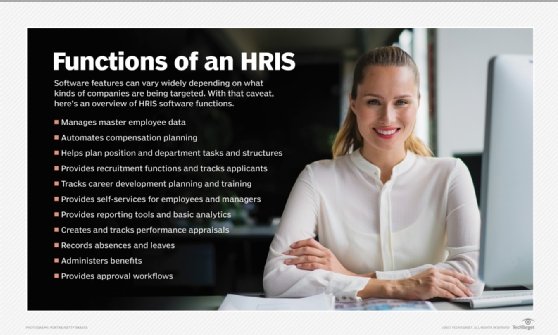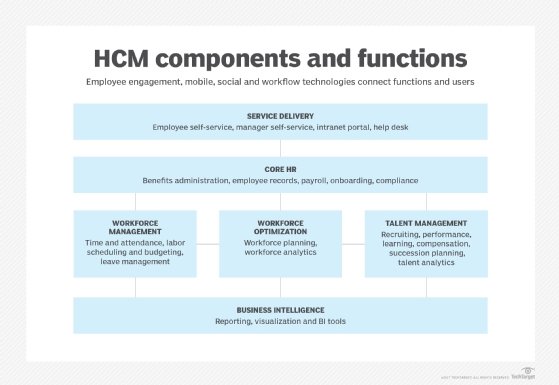HRIS vs. HRMS vs. HCM: Key differences and similarities
Learning what the terms HRIS, HRMS and HCM mean -- and how they're different -- is an important step in the software buying process. Here are some ways to tell them apart.
The HR tech marketplace can seem like one big alphabet soup, and getting clear on the main types of HR systems is essential before buying.
The technologies that likely cause the most confusion when choosing an HR software system are some of the most important to understand: HRIS, HRMS and HCM.
Here's a look at HRIS vs. HRMS vs. HCM and the differences and similarities between them.
What is HRIS?
A human resource information system (HRIS) is software designed to provide a centralized repository of employee data and other features needed to manage core HR, or the basic processes and administrative functions of an HR department. The most common ones are employee records management, benefits administration, payroll, reporting, analytics, absence management, organizational charts, job descriptions and employee and manager self-service.
An HRIS might also support the basic documentation and administrative tasks of some talent management processes, such as recruiting, applicant tracking, training administration and performance management.
What is HRMS?
According to most sources, a human resource management system (HRMS) is the same as an HRIS, though some say an HRMS adds a full complement of talent management modules to the typical HRIS functions.
What is HCM?
Human capital management (HCM) is a comprehensive set of practices and tools used for recruiting, managing and developing employees.
HCM goes far beyond the mostly administrative functions of core HR to include the more strategic "soft" disciplines geared to developing people's potential, such as talent management and employee engagement. It views employees as valuable assets that leaders need to manage strategically. HCM practices help guide HR teams on how to act proactively, rather than reactively, to get the best value from a workforce.
HCM is also the name of the broadest category of HR software: HCM suites that combine core HR with talent management and newer HR tools, such as employee surveys, engagement and recognition.
Differences between HRIS vs. HRMS
In most HR circles, an HRIS and an HRMS are considered the same thing. The HR tech industry has largely moved away from differentiating between the two.
The one area where HRIS has a different meaning than HRMS is in denoting the IT positions in an HR department. The most common position is HRIS administrator, the person responsible for updating and maintaining the HRIS and educating other employees on how to use it.

Comparing HRMS vs. HRIS vs. HCM
As noted, HCM refers to much broader software suites and more expansive employee management functions than are typically handled in an HRIS or HRMS.
For example, HCM software usually has talent management features that provide ways to better manage and optimize each stage of the employee lifecycle, such as recruiting, onboarding, performance management, learning, succession planning, compensation planning and employee engagement. An HCM suite might also include workforce management functions, such as workforce planning, analytics and scheduling.
HCM suites can be on premises or cloud-based, though the latter is increasingly the preferred choice. Cloud computing provides a number of benefits, such as easier software updates, better scalability and a need for fewer IT resources.

HRMS, HRIS and HCM: Common goals and benefits
All three terms refer to systems designed for the same broad purpose. They digitize and partially automate the work of HR departments, along with the far-reaching HR-directed processes that the rest of the organization participates in, such as performance management, recruitment and training.
The potential benefits are wide ranging and significant. They include improved employee retention, innovation and productivity, lower turnover, reduced labor costs and ultimately, higher profits. HR systems are also increasingly the platform used to measure and improve the overall employee experience, which can boost employee satisfaction and loyalty and in turn lead to better customer satisfaction.
What matters in choosing an HR system
The most important thing when shopping for HR technology is understanding the HR software features your organization needs and whether a particular vendor's software can deliver them.
The first step is defining the organization's HR challenges, needs and goals, then establishing a buying team made up of a representative sample of executives, departmental managers and IT. The team then manages a requirements-planning process in which stakeholders say what they need a new HR software system to do, ranking the capabilities by importance.
The buying team scans the market in search of the best HR software that could potentially meet the requirements and sends a request for proposal to a shortlist of the most promising vendors.
After examining the vendors' responses, the buying team calls in a subset of finalists to demo their products using actual use cases from the organization.
By this stage, you're well on your way to naming the product that best meets your needs and signing a contract with the vendor.







